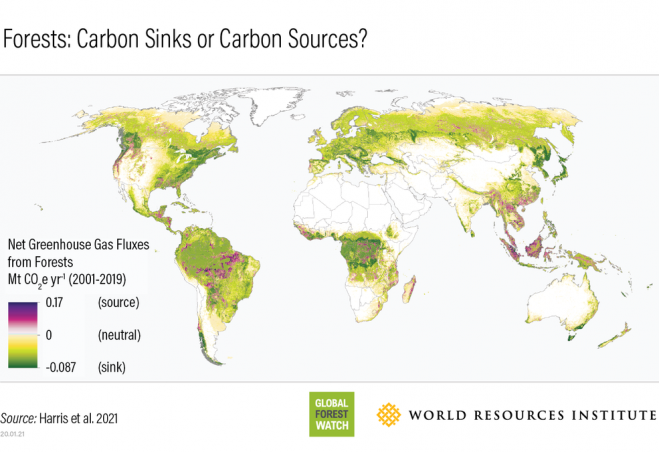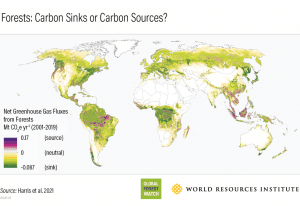

A world map shows forested regions that are sources of carbon emissions (purple) and where they are carbon sinks (green), or areas that absorb and store carbon from the atmosphere. (Credit: Harris et al. 2021 / Global Forest Watch / World Resources Institute)
Using ground, airborne and satellite data, a diverse team of international researchers—including NASA scientists—created a new method to assess how the changes in forests during the last two decades impacted carbon concentrations in the atmosphere.
In addition to better understanding the overall role of forests in the global carbon cycle, the scientists were also able to distinguish between the contributions of various forest types, confirming that among forests, tropical forests are those responsible for the largest component of global carbon fluctuations—both absorbing more carbon than other forest types, and releasing more carbon into the atmosphere due to deforestation and degradation.
While clearing land for agriculture, industry and other human activities increases carbon dioxide in the atmosphere, the primary cause of the global carbon dioxide increase over the last century is from human activities that burn fossil fuels such as coal and oil. On balance, trees and other plants pull carbon dioxide out of the atmosphere.
The forest carbon flux map from web-application Global Forest Watch, and accompanying study published in Nature Climate Change on Jan. 21, 2021, show these carbon fluctuations from forests in unprecedented detail. This was published just one day after the United States rejoined the Paris Climate Agreement—an international effort to limit global temperature rise that specifically highlights reducing emissions from deforestation and forest degradation.
Through photosynthesis, forests absorb carbon dioxide from the atmosphere to produce oxygen, complementing the collective breathing of other life on Earth that inhales oxygen and expels carbon dioxide.
According to the researchers, forests collectively absorbed around 15.6 billion metric tons of carbon dioxide from Earth’s atmosphere each year between 2001 and 2019, while deforestation, fires and other disturbances released an average of 8.1 billion metric tons of carbon dioxide per year. Forests around the world are estimated to absorb about 7.6 billion metric tons, acting as a net carbon sink of roughly 1.5 times the annual emissions from the entire United States.
